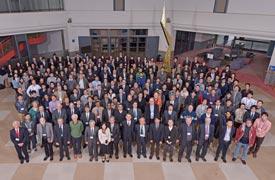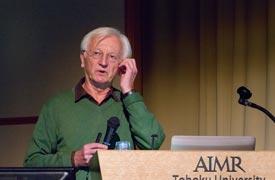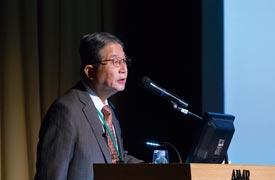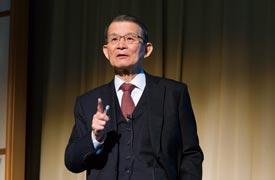

03/28/2016

Since being appointed director of the AIMR in 2012, Motoko Kotani has led the charge in promoting collaboration between mathematics and materials science. To keep abreast of the fields’ newest crossbreeds, researchers from all over the world travel to Sendai every February for the AIMR International Symposium (AMIS). This year’s theme was ‘harmonious collaboration between mathematics and materials science’.
“When we started this initiative, the distance between mathematics and materials science was very wide,” explained Kotani. “But now materials scientists have started putting more emphasis in the direction of using mathematical modeling, information technology and data-driven science. To achieve this, direct interaction between mathematicians and materials scientists — experimental researchers in particular — is important. We just started this process a bit earlier.”
Speakers at the three-day event on 22–24 February presented research on everything from tiny molecular machines that could one day power factories invisible to the naked eye, self-cleaning and antibacterial materials for glazing surfaces at hospitals and sports stadiums, to a fast-track route to developing new structural materials that will reduce our dependence on rare metals and rare-earth elements.
Tohoku University President Susumu Satomi welcomed participants to the opening ceremony. More than 230 researchers representing 14 countries attended the symposium, including 22 invited speakers and 104 poster presenters. Satomi thanked Director Kotani and the AIMR for upholding a legacy of pioneering materials science and establishing extensive international networks. “The AIMR is expected to play a very important role toward achieving the goals of Tohoku University,” he said, referring to the adoption of system reforms and the promotion of the university in global forums.
The next speaker was Toshio Kuroki, program director of the World Premier International Research Center Initiative (WPI), who disclosed plans to continue the prestigious national project. In 2014, a WPI program committee assessed that the five inaugural WPI centers, including the AIMR, had achieved ‘world premier status’. As a result of their success, the government is discussing plans to continue the WPI program. The WPI program will also establish a grants scheme to support system reforms and internationalization activities in centers that have completed their ten-year term. The highly cited science and interdisciplinary research that exemplify the WPI brand will be sustained by the WPI centers and their host institutions — in the case of the AIMR, this will be through the newly established Organization for Advanced Studies.
AIMR Director Kotani promised to do her best “to keep the present activity of the AIMR as a world-leading hub of global brain circulation in materials science.” In 2012, the AIMR initiated three target projects to strengthen ties between mathematics and materials science. In 2013, the AIMR introduced a fourth target project named Core Technology for Nano Energy Devices to translate the results of these harmonious collaborations into materials, devices and systems that will help solve global energy problems. AMIS2016 focused on this fourth target project and its practical applications, an area in which the AIMR has made significant progress through research into novel energy generation and storage materials, lithium-ion batteries, quantum-dot solar cells, thermoelectric conversion elements, nano-electronic switching devices and light-emitting diodes.

A series of scientific presentations followed the opening remarks. Alexander Mikhailov, a theoretician at the Fritz Haber Institute of the Max Planck Society, presented his work on the use of mathematical models to explain, control and mimic complex phenomena such as those occurring in living cells. Packed inside the many cubic micrometers of a cell is a factory of nanoscale machines — motors, ion pumps and enzymes. These tiny biomolecules operate on millisecond timescales in extremely turbulent environments.
The chemical structure of these proteins is generally known, but their movement is harder to track. A popular but problematic technique involves running detailed molecular dynamics simulations of every atom in the protein. “Even using the best supercomputers, we can only follow the dynamics of a single protein for up to one microsecond, which is 10,000 times shorter than a single operation cycle,” said Mikhailov. His group instead uses simple and efficient elastic network models that produce coarser representations of proteins as a series of amino acid ‘beads’ connected by elastic ‘springs’. These models are so simple that they can run on a personal computer.
In 2010, Mikhailov’s team used these models to identify how the hepatitis C virus helicase splits DNA — “the first structurally resolved simulation for a motor protein.” More recently, the team has designed a molecular machine that swings forward using a ratchet mechanism similar to that used by actin and myosin filaments when a muscle contracts.

Presenting another material that mimics processes found in living organisms was renowned chemist and president of Tokyo University of Science, Akira Fujishima. He recounted his discovery in 1967 of titanium dioxide’s ability to use light to split water like in photosynthetic plants; the results were published in Nature in 1972. Fujishima later found that titanium dioxide has a strong affinity for water and oils when irradiated by ultraviolet light. He has spent the last half century characterizing the photolytic, photocatalytic and superhydrophilic properties of this versatile material and developing affordable applications.
“Titanium dioxide is the best material — it’s very cheap and safe and can be used to coat surfaces as a transparent film,” he said. The material has been used to filter out the smell of cigarettes in bullet trains, maintain the stainless exteriors of train stations and football stadiums, prevent fogging of rear- and side-view mirrors, and kill bacteria and viruses that colonize hospital tiles. Fujishima is now trying to develop new applications for this material in water purification, solar light transmission and mosquito repellents. Meanwhile, scientific interest in titanium dioxide shows no sign of abating: close to 11,000 articles have cited Fujishima’s original Nature paper according to the Web of Science and the number of publications on photocatalysis increases annually.

After a break, Teruo Kishi introduced several large-scale projects on structural materials funded by the Japan government to support the aviation, automobile and energy industries. Most recently, the Cabinet Office has set aside 3.5 billion yen to develop strong, lightweight and heat-resistant metals, alloys, ceramics, polymers and resins. These materials will reduce the energy and carbon footprint of air travel and power generation and make Japan less reliant on imports of rare-earth metals and other critical elements. As director of the Structural Materials for Innovation program, Kishi will manage a five-year collaboration between 27 industry partners, 35 universities and 130 scientists. He plans to integrate computer science and informatics with existing theoretical and experimental techniques in materials science to develop tools that can predict the performance of materials for rapid development and testing.
From big-picture science to a focus on synthesis, Kenichiro Itami, synthetic chemist and director of the WPI Institute of Transformative Bio-Molecules, presented his team’s work on carbon-based nanomaterials. Nanocarbons have been a hot topic for fundamental research and applied science since the discovery of spherical fullerene in 1985, cylindrical carbon nanotubes in 1991 and graphene sheets in 2004, explained Itami. But these molecules are typically only available as mixtures of varying sizes, which means that their bulk properties represent an average of the individual molecules’ properties.
Itami’s group uses organic chemistry to create structurally uniform nanocarbons from flat or ring-shaped molecular templates, which could yield entirely new properties. “The beauty of science is purity,” he said. Itami’s team has since synthesized the shortest carbon nanotube with an armchair pattern, and accidentally synthesized a three-dimensional nanocarbon that has the negative curvature familiar to munchers of Pringles potato chips. The unique topology of the structure has even intrigued theoretical scientists. “Mathematicians are so excited about it,” said Itami.
The opening session concluded with another chemist, AIMR principle investigator and president of the University of Science and Technology of China, Li-Jun Wan. His team focuses on the surface of materials, finding ways to assemble organic molecules in highly ordered patterns for potential application on functional devices, such as sensors. Specifically, Wan’s group has laid out large sheets of graphene-like materials in which the individual molecules are connected via strong covalent bonds. “We really need mathematicians to join us to predict new structures and properties,” said Wan. “I can find many collaborators at the AIMR to exchange ideas and results.”